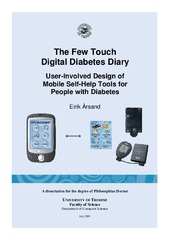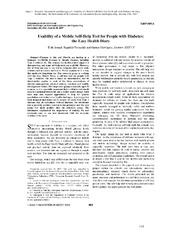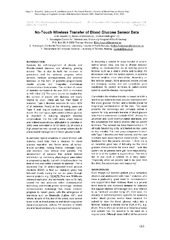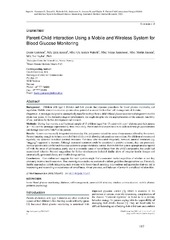| dc.description.abstract | Paradoxically, the technological revolution that has created a vast health problem due to a drastic change in lifestyle also holds great potential for individuals to take better care of their own health. The first consequence is not addressed in this dissertation, but the second represents the focus of the work presented, namely utilizing ICT to support self-management of individual health challenges. As long as only 35% of the patients in Norway achieve the International Diabetes Federation‟s goal for blood glucose (HbA1c), actions and activities to improve blood glucose control and related factors are needed. The presented work focuses on the development and integration of alternative sensor systems for blood glucose and physical activity, and a fast and effortless method for recording food habits. Various user-interface concepts running on a mobile terminal constitute a digital diabetes diary, and the total concept is referred to as the “Few Touch application”.
<br/>The overall aim of this PhD project is to generate knowledge about how a mobile tool can be designed for supporting lifestyle changes among people with diabetes. Applying technologies and methods from the informatics field has contributed to improved insight into this issue. Conversely, addressing the concrete use cases for people with diabetes has resulted in the achievement of ICT designs that have been appreciated by the cohorts involved. Cooperation with three different groups of patients with diabetes over several years and various methods and theories founded in computer science, medical informatics, and telemedicine have been combined in design and research on patient-oriented aids. The blood glucose Bluetooth adapter, the step counter, and the nutrition habit registration system that have been developed were all novel and to my knowledge unique designs at the time they were first tested, and this still applies to the latter two. Whether it can be claimed that the total concept presented, the Few Touch application, will increase quality of life, is up to future research and large-scale tests of the system to answer. However, results from the Type 2 diabetes half-year study showed that several of the participants did adjust their medication, food habits and/or physical activity due to use of the application. | en |
| dc.description | Paper number 2, 4, 5 and 7 are not available in Munin, due to publishers' restrictions:
<br/>2. Å…rsand E, and Demiris G.: "User-Centered Methods for Designing Patient-Centric Self-Help Tools", Informatics for Health and Social Care, 2008 Vol. 33, No. 3, Pages 158-169 (Informa Healthcare). Available at <a href=http://dx.doi.org/10.1080/17538150802457562>http://dx.doi.org/10.1080/17538150802457562</a>
<br/>4. Å…rsand E, Olsen OA, Varmedal R, Mortensen W, and Hartvigsen G.: "A System for Monitoring Physical Activity Data Among People with Type 2 Diabetes", pages 173-178 in S.K. Andersen, et.al. (eds.) "eHealth Beyond the Horizon - Get IT There", Proceedings of MIE2008, Studies in Health Technology and Informatics, Volume 136, May 2008, ISBN: 978-1-58603-864-9
<br/>5. Årsand E, Tufano JT, Ralston J, and Hjortdahl P.: "Designing Mobile Dietary Management Support Technologies for People with Diabetes", Journal of Telemedicine and Telecare, 2008 Volume 14, Number 7, Pp. 329-332 (Royal Society of Medicine Press). Available at <a href=http://dx.doi.org/10.1258/jtt.2008.007001>http://dx.doi.org/10.1258/jtt.2008.007001</a>
<br/>7. Årsand E, Walseth OA, Andersson N, Fernando R, Granberg O, Bellika JG, and Hartvigsen G.: "Using Blood Glucose Data as an Indicator for Epidemic Disease Outbreaks", pages 199-204 in R. Engelbrecht et.al. (eds.): "Connecting Medical Informatics and Bio-Informatics", Proceedings of MIE2005, Studies in Health Technology and Informatics, Volume 116, August 2005, ISBN: 978-1-58603-549-5. <a href=http://x-port-sfx.uio.no/sfx_ubto?sid=BIBSYS:Ask&pid=BIBSYS:BIBLIO:070606897&genre=book&title=Connecting+medical+informatics+and+bio-informatics+%3A+proceedings+of+MIE2005%2C+the+XIXth+International+Congress+of+the+European+Federation+for+Medical+Informatics+%2F+edited+by+Rolf+Engelbrecht+...+[et+al.]&>Check availability</a> | en |


 English
English norsk
norsk


